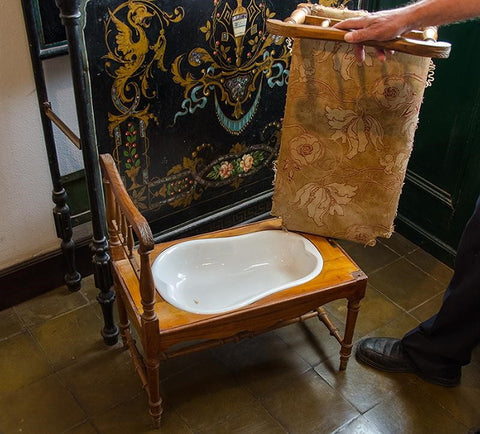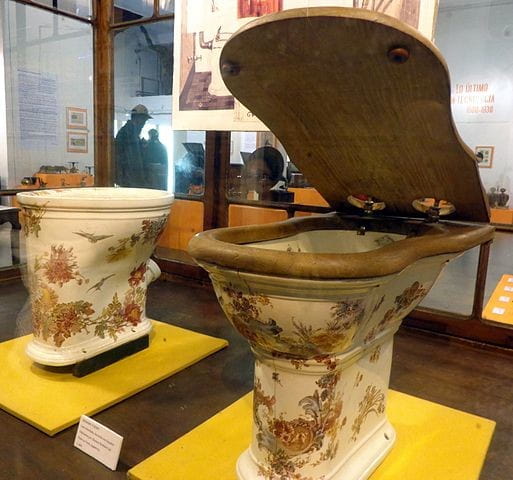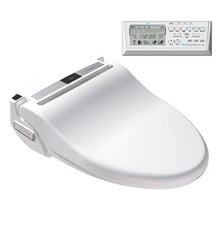Thank you for visiting Bidet.org. Due to toilet paper shortage, people have learned about bidets and the demand has increased significantly. Add in the fact that there are staffing restrictions and delays in delivery, there is a nation wide shortage of bidets. We are using this page to help direct our visitors to the products we have in stock. Please be advised that stock is changing so fast there are times we must refund or with your permission send a similar model.
This page will be updated daily.
Current Stock
Brondell Swash 1400 - Electronic bidet seat, click here for product info.
Bio Bidet Bliss 2200 - Electronic bidet seat, click here for product info. Ships in May
Bio Bidet Bliss 1700 - Electronic bidet seat, click here for product info.
Bio Bidet Supreme 1000 - Electronic bidet seat, click here for product info.
Bio Bidet Prestige 800 Elongated - Electronic bidet seat, click here for product info.
Bio Bidet BB-70 Bidet Attachment - Non-electronic bidet attachment, click here for product info.
Luxe Bidet Neo 110 (limited stock) - Non-electronic bidet attachment, click here for product info.
Luxe Bidet Neo 320 (limited stock) - Non-electronic bidet attachment, click here for product info.
Read more +
Pruritus Ani, also commonly called anal itching, is a simple problem that doctors treat all the time. Often anal itching is the result of a drying out of the mucous membranes that make up the anus or because these tissues have been irritated by toilet paper which is dry and can be quite rough on your bum. Sometimes this itching can be caused from hemorrhoids, and at times it may be the result of failing to thoroughly clean the anus properly and fecal residue is still present.
 Anal itching is not a serious medical condition that requires medical treatment but it can make life miserable if you suffer from this problem. In addition to itching the same conditions and causes can also result in anal abrasions, skin tears in and around the anus, rectal bleeding, dry skin that is sensitive, soreness, burning, and discomfort. Many people who experience anal itching start using wet wipes in order to try and relieve the problem but is this really the answer? Some medical professionals are warning that using wet wipes instead of toilet paper or simple water could cause anal rashes and serious skin problems in the nether regions.
Anal itching is not a serious medical condition that requires medical treatment but it can make life miserable if you suffer from this problem. In addition to itching the same conditions and causes can also result in anal abrasions, skin tears in and around the anus, rectal bleeding, dry skin that is sensitive, soreness, burning, and discomfort. Many people who experience anal itching start using wet wipes in order to try and relieve the problem but is this really the answer? Some medical professionals are warning that using wet wipes instead of toilet paper or simple water could cause anal rashes and serious skin problems in the nether regions.
What is the Problem with Wet Wipes?
Wet wipes eliminate the dry rough texture that toilet paper can have on the sensitive mucous membrane that makes up the anus, but these products can contain ingredients that could leave you regretting the decision to use wet wipes in the first place. Many brands of wet wipes contain methylchloroisothiazolinone or MCI, alcohol, or even both, and this can cause problems when they are used in the anal and genital area. In fact physicians have known for some time that the preservatives and chemicals that may be used in wet wipes can cause problems including rashes and skin irritation.
The Mayo Clinic Report
A recent report published in the online version of the Archives of Dermatology on June 21, 2010, from Mayo Clinic researchers provides evidence that wet wipes can be a serious issue for some individuals. The report focuses on methylchloroisothiazolinone, also referred to as MCI, and the reactions caused by this single chemical. Mayo Clinic physicians looked at four cases where wet wipes which contained MCI caused medical problems.
One patient, a 49 year old who worked as a mailman, developed a severe rash around his anus that was so painful it made walking impossible. Several doctors had previously tried to treat the patient's rash without success. The man had to take a two month leave of absence from work because the rash was so bad. Once the patient stopped using the wet wipes the rash cleared up and the patient could resume normal activities.
Another patient discussed in the report from the Mayo Clinic used wet wipes for around two decades, and he suffered from psoriasis so when he developed a rash between his buttocks and around his anus he assumed that his psoriasis was the cause. After the patient stopped using wet wipes the rash cleared up completely within 6 weeks.
According to the researchers who published the Archives of Dermatology report "Patients with (rashes around their anus) often continue to use the moist toilet paper with the belief that the cleansing will help heal the lesions. They may not make the correlation that the moist toilet paper is the culprit."
Wet Wipes May Also Contain Alcohol
MCI is not the only culprit when it comes to anal itching and associated anal problems, alcohol can be found in many wet wipes on the market as well and this substance damages the anal tissues and surrounding skin. Alcohol dries out the mucous membrane and this leads to irritation which can cause itching. Dry anal tissues can also result in small tears in the anus which can bleed, cause pain, and even lead to infection if the tears are not properly cleaned on a regular basis.
Wet Wipes Pose a Threat to Sewage Systems
While many wet wipes are marketed as flushable this is not actually true. In fact these wipes pose such a threat to sewer systems that the officials in New York City have taken steps to ban the use of the word flushable on packages of wipes. New York City council members Donovan Richards and councilman Antonio Reynoso actually introduced a bill to ban wet wipes being marketed as flushable after they became aware of the problems that these products were causing and the cost to taxpayers.
City officials in New York City reported that sewage workers were having to remove tens of thousands of these wipes from the sewage system to prevent or eliminate clogs, and this was a daily number and showed how many wipes were removed in a single day. New York City is not the only city affected by this issue either, cities across the USA have reported an increase in wet wipe use and problems caused by wet wipes in the city sewer systems. Since these wipes do not break down and degrade as fast as toilet paper they pose a hazard to the environment and sanitation equipment.
Bidets can Help with Anal Itching Without Any Drawbacks
Instead of using wet wipes to eliminate your anal itching you may be better off looking at bidet products instead. A bidet uses clean water and is a gentle and effective solution. Many dermatologists and other medical professionals recommend cleaning your anus with water instead of using dry toilet paper or wet wipes. A bidet offers many benefits and can help relieve anal itching without any of the possible side effects or risks of wet wipes.
Resources:
https://www.bidet.org/blogs/news/17473948-baby-wipes-vs-bidets
http://www.citypages.com/news/wet-wipes-cause-awful-anal-rashes-mayo-clinic-warns-6551685
http://www.reuters.com/article/us-wet-wipes-cause-rashes-idUSTRE65K6FD20100621?feedType=RSS&feedName=healthNews&utm_source=feedburner&utm_medium=feed&utm_campaign=Feed%3A+reuters%2FhealthNews+%28News+%2F+US+%2F+Health+News%29
http://www.healthcommunities.com/anal-health/anal-itching.shtml
http://www.stltoday.com/lifestyles/health-med-fit/health/peoples-pharmacy/a-bidet-may-be-good-way-to-treat-anal-itching/article_6f52e8ba-77c0-58c8-b75a-df9b0bb36b6d.html
http://www.rodalesorganiclife.com/wellbeing/toilet-wipes
Read more +
An alarming article warned bidets are dangerous if you are fasting. We say that’s not true, here’s why
Read more +
 Ever wanted to know the history of how the modern bidet came to be? From primitive buckets to Napoleon’s silver bidet, here’s everything you need to know about the history of the bidet.
Ever wanted to know the history of how the modern bidet came to be? From primitive buckets to Napoleon’s silver bidet, here’s everything you need to know about the history of the bidet.
If you’ve spent any amount of time traveling the world, then you’ve no doubt come across a few bidets in your lifetime. They come in all shapes and sizes and in some places they completely take the place of toilet paper. One of the strangest things for many tourists to get used to are the different toilet habits practiced in different countries.
Depending on where you are, you may come into contact with quite a few different styles of bidets. At their most primitive, they are small containers of water with a special pouring cup. At their most advanced, they are fully robotic toilet seat attachments with self-cleaning anti-microbial technology and laser-sharp aim.
Some love them, some hate them. Regardless of your stance, however, wouldn’t you be interested to know where they came from and who was the first to use them?
Well, today we’re going to take a dive into the history of this interesting toilet technology and do our best to answer some of these pressing questions.
A Brief History of the Bidet
It’s almost impossible to pinpoint the first-ever use of a bidet. After all, it doesn’t take a lot of ingenuity to wash yourself with water after you use the toilet. However, the bidet itself isn’t just a means of cleaning yourself with water, but rather an artistic or technologically-oriented design meant to make the user feel clean and comfortable about what they were doing.
Who Had Them First?

The word “bidet” has a very European ring to it doesn’t it? Among toiletologists, the debate is that either the Italians or the French created the first widely-used fancy bidet system. According to the World Toilet Organization (yes there is such a thing), the term was first coined in 1710 in a French publication, so historians tend to lean more towards the French side.
Most give credit to the French furniture maker Christopher Des Rosiers for creating one of the world’s first bidets. Once they came into style they weren’t going out. Bidet crafting became an ornate art form, and it turned the act of using the bathroom into a stylish and classy experience.
After handling their business, the wealthy French aristocrats could clean themselves in a porcelain bowl with beautiful inlay and painting work laid into an ornate mahogany chair. This was one of the first times in recorded history that toilets were designed to be nice. Up until then, even the wealthiest kings and queens of the world still had to use a traditional stone or wood-carved latrine and were lucky if they had some extra water for plumbing purposes.
“Bidet” is actually the French word for “pony.” Likely this term was created as a euphemism to describe the way that one would straddle the fancy bowl to clean themselves.
The affluent members of French society weren’t “going to wash their bums in a bowl,” they were instead going to “visit Le Bidet.” Sounds a lot nicer doesn’t it?
Napoleon’s Bidet
One of the most well-known bidets in recent history was Napoleon Bonaparte’s silver bidet which he took with him in all of his travels. The silver acted as a natural anti-microbial and kept the piece of furniture clean and sanitary no matter where he was. It was so important to him that he even passed it down to his son in his last will and testament.
The Spread of Bidets Across the World
Despite their aristocratic beginnings in the French courts, bidets have since spread all across the world. In many foreign countries, however, they aren’t known by the name “bidet” which means that these countries may very well have had their own versions long before the French. Unfortunately, there isn’t any recorded evidence to back this up, but it is a solid theory.

The more prevalent theory is that bidets were traded around the world. At one point in history, France was one of the most well-known trading countries in the world. People as far away as China were eager to get their hands on the latest French styles, perfumes, and furniture. In French courts, diplomats from Asian and Indian countries would visit, and take note of these fancy bidets. It’s likely that they came home and hired their own craftsmen to build their own.
One interesting thing to note is the different styles of bidets. Some are simple handheld spray guns, others shoot a singular stream of water, and some feature multiple spouts. If you’re willing to shell out some serious money, then you can even get a fully-automated bidet with robotic cleaning spouts, anti-microbial sanitizing technology and motion-sensing lids.
Since the first French artisanal bowls, bidets have certainly come a long way. There are bidets of all types and sizes that range from affordable to high-end. All of this goes to show that once you come up with a good piece of technology, there’s no limits to how far you can take it. The first bidet was engineered by a humble French furniture craftsman. Now, they’re engineered and built all over the world.
Sources:
1. https://www.nytimes.com/2015/04/30/technology/personaltech/electronic-bidet-toilet-seat-is-the-luxury-you-wont-want-to-live-without.html
2. https://web.archive.org/web/20091220192053/http://www.worldtoilet.org/resources.asp?no=6
3. https://www.napoleon.org/en/history-of-the-two-empires/articles/napoleons-last-will-and-testament/
Read more +
If you’ve got money to blow, deserve your own personal throne, and enjoy the unbeatable feeling of a bidet, then this article is for you. Here are some of the world’s most expensive bidet toilets.
Read more +

 Anal itching is not a serious medical condition that requires medical treatment but it can make life miserable if you suffer from this problem. In addition to itching the same conditions and causes can also result in anal abrasions, skin tears in and around the anus, rectal bleeding, dry skin that is sensitive, soreness, burning, and discomfort. Many people who experience anal itching start using wet wipes in order to try and relieve the problem but is this really the answer? Some medical professionals are warning that using wet wipes instead of toilet paper or simple water could cause anal rashes and serious skin problems in the nether regions.
Anal itching is not a serious medical condition that requires medical treatment but it can make life miserable if you suffer from this problem. In addition to itching the same conditions and causes can also result in anal abrasions, skin tears in and around the anus, rectal bleeding, dry skin that is sensitive, soreness, burning, and discomfort. Many people who experience anal itching start using wet wipes in order to try and relieve the problem but is this really the answer? Some medical professionals are warning that using wet wipes instead of toilet paper or simple water could cause anal rashes and serious skin problems in the nether regions. Ever wanted to know the history of how the modern bidet came to be? From primitive buckets to Napoleon’s silver bidet, here’s everything you need to know about the history of the bidet.
Ever wanted to know the history of how the modern bidet came to be? From primitive buckets to Napoleon’s silver bidet, here’s everything you need to know about the history of the bidet.





